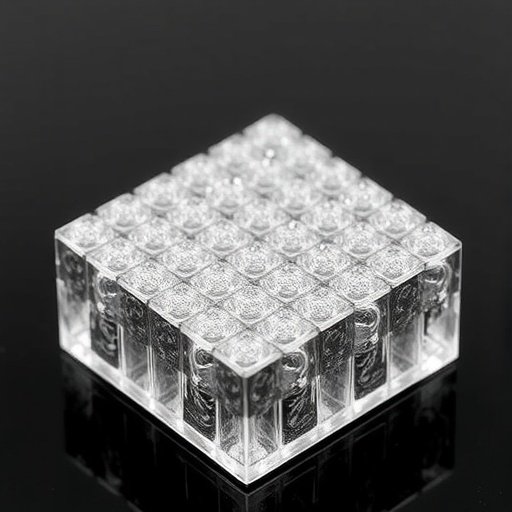In recent developments in battery technology, the quest for more efficient and lightweight electrodes has led researchers to explore innovative approaches to electrode fabrication. A groundbreaking study led by Lei et al. has brought forth a promising technique in the world of energy storage. Their research, published in Ionics, focuses on the optimization of binder-free cobalt-nickel phosphate battery-type electrodes using a sonochemical-assisted chemical bath deposition (CBD) approach. This novel method represents a significant advancement in creating more effective energy storage solutions.
The study embarks on a critical examination of conventional electrode materials, which often rely on binders that can detract from overall electrochemical performance. By removing the binder layer, the researchers aim to enhance ionic and electronic conductivities, thus improving charge storage capacity and accelerating electrochemical reactions. This move aligns with the industry’s direction toward slimmer and more efficient energy sources capable of meeting modern demands.
Sonochemical-assisted chemical bath deposition is at the heart of this research. This technique utilizes ultrasound waves to agitate the solution during the deposition process, enhancing the interaction between the cobalt and nickel ions in the bath. The ultrasound generates localized high temperatures and pressures, leading to increased nucleation rates and better quality of the deposited film. This improved deposition technique promises to yield electrodes with superior structural integrity and electrochemical properties.
The significance of cobalt and nickel phosphate compounds in battery applications cannot be overstated. These materials excel due to their high theoretical capacity and favorable electrochemical characteristics. Cobalt’s role in battery technology has been well documented, while nickel introduces enhanced stability and efficiency during charge and discharge cycles. The synergistic effect of these two metals enhances energy density and prolongs battery lifespan, making them ideal candidates for advanced battery formulations.
The research meticulously describes the parameters of the sonochemical deposition process, which were fine-tuned to achieve optimal results. Key parameters such as temperature, deposition time, and concentration of reactants were all rigorously examined. Initial tests established a baseline for performance, with variations in these parameters providing insights into their influence on the composition and morphology of the electrodes.
A notable aspect of the study is the characterization techniques used to analyze the properties of the deposited films. Scanning electron microscopy (SEM) was employed to observe the surface morphology and structural features of the electrodes. The results indicated a uniform and dense surface, characteristic of high-quality films, leading to improved electrochemical properties. Additionally, energy-dispersive X-ray spectroscopy (EDX) was utilized to confirm the elemental composition, ensuring the successful incorporation of cobalt and nickel into the phosphate structure.
The electrochemical performance of the binder-free cobalt-nickel phosphate electrodes was evaluated using cyclic voltammetry and galvanostatic charge-discharge tests. The results showcased remarkable specific capacity and excellent rate capability, outpacing many conventional electrode materials. The electrode’s performance stability was also assessed, revealing minimal degradation over numerous charge-discharge cycles—a critical factor for practical applications.
The findings from Lei et al. carry significant implications for the future of battery technology. By providing a method to fabricate binder-free electrodes that can exhibit superior electrochemical properties, this research opens new avenues for the development of more efficient and sustainable energy storage solutions. The implications extend to electric vehicles and portable electronics, where the demand for high-performance batteries is ever-increasing.
This study is expected to inspire further research in the field of advanced electrode materials. By exploring different metallic combinations and deposition techniques, scientists can potentially uncover even more robust materials that meet the challenges posed by burgeoning energy demands. The experiment underscores the potential of sonochemical methods in synthesizing innovative materials for next-generation batteries.
In conclusion, Lei et al.’s work offers a promising glimpse into the future of battery technology through the optimized formulation of cobalt-nickel phosphate electrodes. The integration of sonochemical-assisted deposition techniques has demonstrated substantial improvements in electrochemical performance, paving the way for binder-free electrodes that could revolutionize the energy storage landscape. This research sets a precedent for future studies aiming to refine electrode materials, ultimately assisting in the transition to greener energy solutions.
As the world moves toward a more electrified future, the outcomes of this research will resonate through various sectors reliant on efficient energy storage. The advancement of lithium-ion technology, along with alternative chemistries that leverage the findings from this study, highlights the dynamic nature of battery research. With innovations continuously emerging from laboratories around the globe, the next generation of energy storage solutions is on the horizon, promising to enhance both consumer technology and renewable energy integration.
Subject of Research: Optimization of binder-free cobalt-nickel phosphate battery-type electrodes using sonochemical-assisted chemical bath deposition.
Article Title: Optimizing the formulation of binder-free cobalt–nickel phosphate battery-type electrode via sonochemical-assisted chemical bath deposition approach.
Article References: Lei, Q., Gerard, O., Guo, X. et al. Optimizing the formulation of binder-free cobalt–nickel phosphate battery-type electrode via sonochemical-assisted chemical bath deposition approach. Ionics (2025). https://doi.org/10.1007/s11581-025-06749-5
Image Credits: AI Generated
DOI: https://doi.org/10.1007/s11581-025-06749-5
Keywords: Cobalt-nickel phosphate, binder-free electrodes, sonochemical deposition, energy storage, electrochemical performance.




